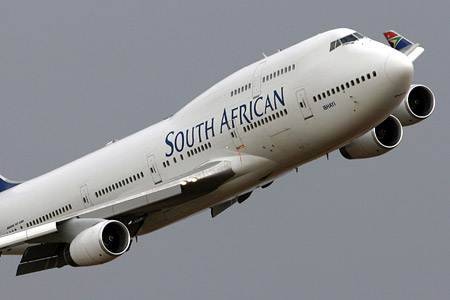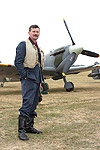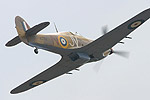Home | Airshows | The Hangar | Nostalgia | Links
Gary Parsons reports from Duxford's Centenary of Flight airshow, 6 & 7 September
|
Centenary
celebs
|
 |
 |
 |
 |
 |
 |
 |
 |
 |
 |
 |
 |
 |
 |
 |
 |
 |
 |
 |
 |
 |
 |
 |
 |
 |
 |
 |
 |
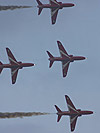 |
Knocking 'em for six
As if the South Africans weren't satisfied enough with usually trashing our cricket team (although we salvaged a draw in the series this time around) it looks as if they now want to steal the thunder at our airshows!
By far the most impressive and memorable sight at this year's September show was the amazingly sprightly performance from the South African Airways Boeing 747-400, cavorting above the Duxford skies like some jet fighter. For such a beast to turn as tight as it did, and as slowly as it seemed, was to suspend the laws of physics for a brief while - just like Brunel's Great Eastern, no way should she float! Pilot Grant McAlpine always had the field in sight - nay, the whites of the eyes in the crowd - as he pulled forty-five degree turns in the short display before spiral-climbing away, a particularly impressive act as the mighty aircraft seemingly hung on its four engines. At a display weight of 210,000kg, she was admittedly only 53% of her maximum, but it's still a whole lotta airplane! It would seem that South African Airways, regular participants at shows overseas, know what the airshow spectator wants with their slick commentary and polished routine - what a contrast to British Airways, who in Concorde's final hours can't be bothered to attend even one airshow.
|
Display
changes
|
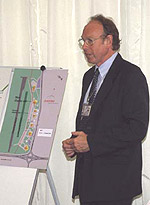 |
|
Dave Eade reports: Ted Inman, head of marketing at Duxford and Steve Cotton, head of Fire and Safety services took the opportunity of the September Airshow to brief the press as to what changes were being made to protect the public, particularly those resident in Duxford. Primarily, these changes involve moving what pilots would call datum some distance to the East, from a line just east of the Tower to an axis in line with the American Museum. This has the effect (very noticeable at the September show) of moving the whole display some 400 metres and aircraft are that distance further away from the village. Other measures include banning aerobatics other than by authorised pilots and a review of the complaints procedure. |
One hopes
that the size of the 747 didn't perturb the residents of nearby Duxford
village, for major changes were affected to the display pattern to counter
concern at the spate of recent crashes that side of the airfield. It has
been something of an Annus Horribilis for the IWM, as is a short
space of time crashes involving the Firefly, L-39 G-OTAF and the Blenheim
in the vicinity of the M11 have stirred the national press into a frenzy
of outrage at the perceived danger of performing 'acrobatics' with these
'old aeroplanes'. It has certainly been an unfortunate two months, but
must be taken in context - no damage to private persons or property has
happened with any incident at Duxford, but even so the IWM considered
that something must be done to allay the fears of the local populace,
so the display datum has been moved some 250m westward, now centring 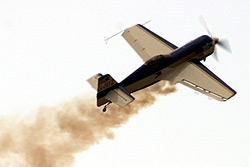 on
the American Air Museum. To accommodate this the crowdline was extended
into the neighbouring field, necessitating an agreement with the landowner
but is also a prelude to more formal discussions on extending the site,
and potentially the runway, further to the west. If successful, the runway
extension would enable a displaced threshold over the M11, negating one
of the criticisms of the IWM's detractors. But, that is a long way off,
so what was the outcome of the new show datum? Certainly aircraft didn't
fly as close to Duxford village as before, and generally the crowd didn't
notice much difference in the proximity of aircraft within the airfield
- a success then, and likely to be a permanent feature from now on.
on
the American Air Museum. To accommodate this the crowdline was extended
into the neighbouring field, necessitating an agreement with the landowner
but is also a prelude to more formal discussions on extending the site,
and potentially the runway, further to the west. If successful, the runway
extension would enable a displaced threshold over the M11, negating one
of the criticisms of the IWM's detractors. But, that is a long way off,
so what was the outcome of the new show datum? Certainly aircraft didn't
fly as close to Duxford village as before, and generally the crowd didn't
notice much difference in the proximity of aircraft within the airfield
- a success then, and likely to be a permanent feature from now on.
Celebrating a century
Celebrating
a century of flight, this year's two-day main event certainly had a different
feel to it, starting with the repositioned jet fighter pan to the eastern
end to the extended crowdline to the west. Sitting on the jet pan and
making a stark contrast with the Tornado F3 was Anders Hansen's Wright
replica, a two-third scale facsimile of the world's first proper aeroplane.
Not a flyer, it taxied down the runway at the start of the show and around
the taxiway, looking  somewhat
out of place amongst the warbird ranks that grace Duxford's flightline.
somewhat
out of place amongst the warbird ranks that grace Duxford's flightline.
Some of these warbirds provided a stirring start to the flying programme, as twelve of them took to the air in a mini-Legends style take-off and flypast, forming the figure 100 as they were shepherded by the T-28 Fennec. Then, breaking to three elements, some spectacular tail-chases ensued, and one could have thought it was that weekend in July rather than September! Great stuff. The rest of the flying programme was not quite a chronological history of flight, but commenced with a Great War scenario and finished (bar Christian Moullec and his Geese - see below) with the Tornado F3 (and Red Arrows on Saturday). The 747 wasn't the only airliner to strut its stuff - Air Atlantique's DC-3 and DC-6 gave an energetic routine, including some opposition passes - quite surreal when you think about it!
Howzat!
 A
good event, sufficiently diverse from the normal Duxford line-up, blessed
with some dry weather (except for a particularly heavy shower on Saturday
afternoon - are weather forecasts pure fiction these days?) and with a
good crowd, despite the draw of an England Football match on TV, Duxford
again proved that it is central to the airshow scene in the UK and can
respond to safety pressures without detracting from the show - maybe its
Annus Horribilis will now be knocked for six.
A
good event, sufficiently diverse from the normal Duxford line-up, blessed
with some dry weather (except for a particularly heavy shower on Saturday
afternoon - are weather forecasts pure fiction these days?) and with a
good crowd, despite the draw of an England Football match on TV, Duxford
again proved that it is central to the airshow scene in the UK and can
respond to safety pressures without detracting from the show - maybe its
Annus Horribilis will now be knocked for six.
Out for a Duck...
It's rare to have an airshow performance that can be described as enchanting, but that is perhaps the best way to sum up the experience of watching Christian Moullec fly his microlight in formation with cranes.
 Christian,
born in Brittany in 1960, has been interested in birds since his childhood.
He is a member of the French equivalent of the Royal Society for the Protection
of Birds and learnt to fly a microlight in order to be able to fly with
them. A meteorologist by profession, he has travelled to some of the most
beautiful and remote corners of the world to study the migration patterns
of various species of bird, but particularly some of the rarer and endangered
varieties of geese. With careful training, the birds accept Christian
and his microlight and come to consider him as their parent, following
him in flight.
Christian,
born in Brittany in 1960, has been interested in birds since his childhood.
He is a member of the French equivalent of the Royal Society for the Protection
of Birds and learnt to fly a microlight in order to be able to fly with
them. A meteorologist by profession, he has travelled to some of the most
beautiful and remote corners of the world to study the migration patterns
of various species of bird, but particularly some of the rarer and endangered
varieties of geese. With careful training, the birds accept Christian
and his microlight and come to consider him as their parent, following
him in flight.
His first successful flight was in 1996 when he flew across part of France accompanied by twelve Barnacle geese. It is through this work that Christian and his wife Paola have been working to save a species of wild goose which is on the brink of becoming extinct by establishing new colonies in other suitable habitats across Europe. Christian and his wife raised Lesser White Fronted Geese in an endangered species project in Sweden and trained the birds to think of his aircraft as their formation leader. With the aid of the microlight, Christian guided them from Sweden via a safe migration route to protected winter quarters on Bislich Island on the Lower Rhine. The birds will subsequently pass on the safe route to future generations.
Says Christian "I thank the birds for the gift they have given me to observe them in flight. It is difficult to describe the feeling of gliding at fifty metres above the open crater of a volcano with twelve geese in regular formation at my side and the sun lying low on the horizon." He flies with both geese and cranes and before each flight, the birds wait patiently until Christian is ready to take off and, as he pushes the throttle of his microlight forward, the birds take off with him so that they all take to the air together. "They are so skilful in the air and I am so awkward!"
For more information about Christian and his work visit www.vol-avec-les-oies.com
Home | Airshows | The Hangar | Nostalgia | Links
